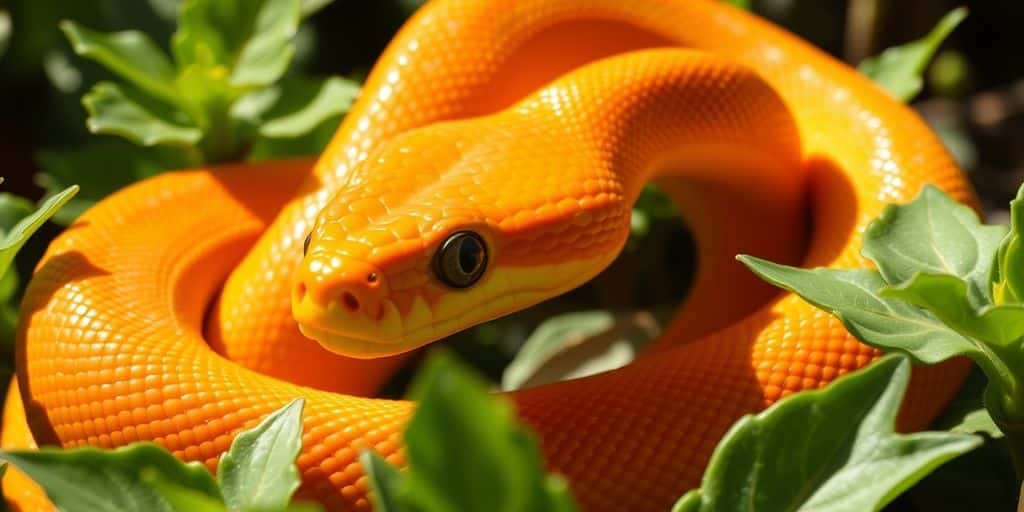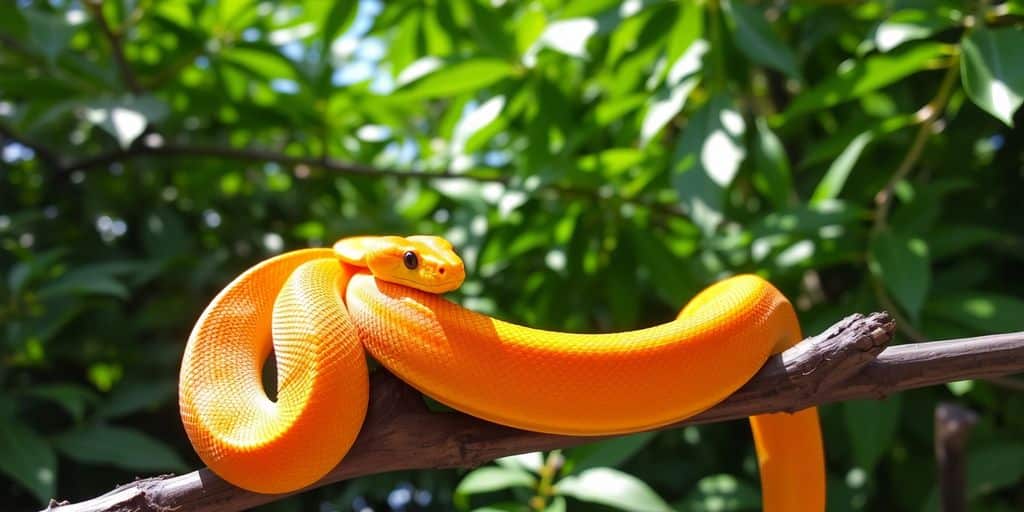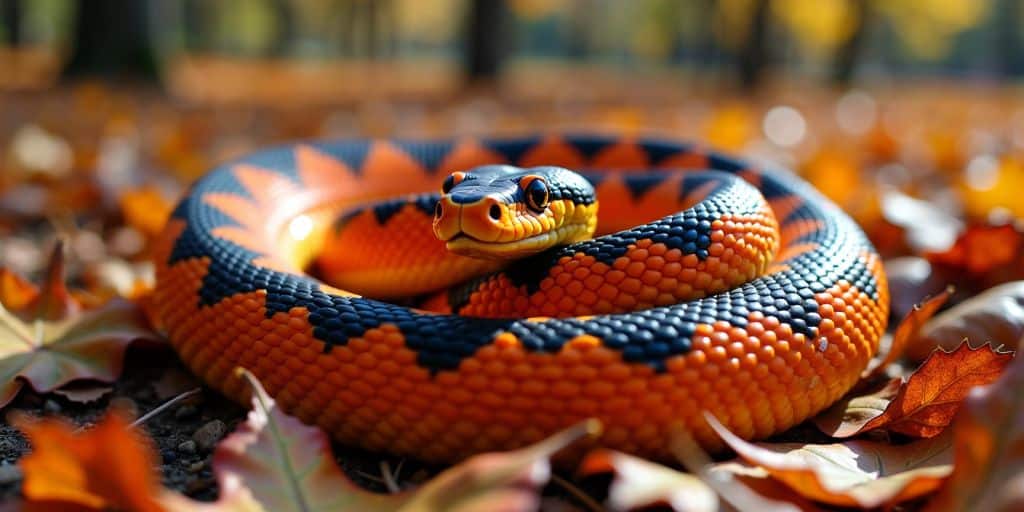The pumpkin snake is a captivating creature that stands out in the world of reptiles. Known for its vibrant colors and unique features, this snake is not just visually appealing but also plays an important role in its ecosystem. In this article, we will delve into the interesting aspects of the pumpkin snake, including its anatomy, habitat, life cycle, and more. Whether you’re a nature enthusiast or just curious about snakes, there’s plenty to discover about this remarkable serpent.
Key Takeaways
- Pumpkin snakes have flexible jaws that allow them to eat prey larger than their head.
- They can change colors to blend into their surroundings, which helps them avoid predators.
- These snakes thrive in various environments, from forests to grasslands.
- The life cycle of a pumpkin snake includes laying eggs and shedding skin as they grow.
- Conservation efforts are crucial to protect pumpkin snakes from habitat loss and other threats.
The Unique Anatomy of the Pumpkin Snake

Flexible Jaws and Feeding Mechanisms
The pumpkin snake has a special jaw structure that allows it to eat prey much larger than its head. This flexibility is crucial for its survival, enabling it to consume various animals. The snake’s jaws can stretch wide apart, making it easier to swallow its meals whole.
Color Changing Abilities
One of the most fascinating features of the pumpkin snake is its ability to change color. This skill helps it blend into its surroundings, providing excellent camouflage against predators. The color change can also be a response to temperature or mood, showcasing the snake’s adaptability.
Scale Structure and Function
The skin of the pumpkin snake is covered in unique scales that serve multiple purposes. These scales not only protect the snake but also assist in movement. The scales are smooth, allowing the snake to glide effortlessly through its environment. Here’s a quick overview of the scale types:
|
Scale Type |
Function |
|
Protective Scales |
Shield against predators |
|
Movement Scales |
Aid in smooth gliding |
|
Coloration Scales |
Help in camouflage |
The pumpkin snake’s anatomy is a perfect example of how nature equips creatures for survival in their habitats. Its unique features make it a remarkable species in the animal kingdom.
Habitat and Distribution of the Pumpkin Snake
Preferred Environments
The Pumpkin Snake thrives in various habitats, including grasslands, woodlands, and even urban areas. They prefer places with plenty of hiding spots, such as rocks and logs, which provide safety from predators and a place to hunt for food.
Geographical Range
Pumpkin Snakes are found in several regions across the globe. Their distribution includes:
|
Region |
Countries/Areas |
|
North America |
United States, Mexico |
|
South America |
Brazil, Argentina |
|
Asia |
India, Thailand |
|
Australia |
Eastern Australia |
Adaptations to Different Climates
These snakes have developed unique adaptations to survive in various climates. For example:
- In hot climates, they are more active during cooler parts of the day.
- In wet environments, they can swim efficiently to find food.
- In cold areas, they may hibernate to conserve energy.
The Pumpkin Snake’s ability to adapt to different environments makes it a resilient species in the wild.
Understanding the habitat and distribution of the Pumpkin Snake helps us appreciate its role in the ecosystem and the importance of conserving its natural environments.
Life Cycle of the Pumpkin Snake

Egg Laying and Hatching
The pumpkin snake begins its life cycle with the laying of eggs. Female pumpkin snakes typically lay between 5 to 20 eggs in a hidden location, such as under leaves or in soft soil. After about 60 to 90 days, the eggs hatch, and the young snakes emerge fully formed and ready to survive on their own.
Growth and Shedding
Once hatched, the young pumpkin snakes grow quickly. They shed their skin several times a year, which is a normal part of their growth process. This shedding allows them to grow and also helps remove parasites. Here’s a quick overview of their growth stages:
|
Stage |
Age Range |
Description |
|
Hatchling |
0-1 year |
Newly hatched, about 10-15 inches long |
|
Juvenile |
1-2 years |
Rapid growth, up to 2-3 feet long |
|
Adult |
2+ years |
Fully grown, can reach 4-6 feet long |
Reproduction and Maturity
Pumpkin snakes reach sexual maturity around 2 years of age. During the breeding season, males will engage in courtship displays to attract females. After mating, females will lay their eggs, continuing the cycle.
The life cycle of the pumpkin snake is a fascinating journey from egg to adult, showcasing the resilience and adaptability of this colorful serpent.
Understanding the life cycle of the pumpkin snake helps us appreciate its role in the ecosystem and the importance of its conservation.
Role of the Pumpkin Snake in the Ecosystem
Pest Control
The Pumpkin Snake plays a vital role in controlling pest populations. By feeding on rodents and insects, these snakes help maintain a balance in their environment. This natural pest control is essential for protecting crops and gardens from damage.
Food Source for Predators
In the food chain, the Pumpkin Snake serves as a significant food source for various predators. Birds of prey, larger snakes, and mammals rely on these colorful serpents for sustenance. This relationship highlights the importance of the Pumpkin Snake in supporting the ecosystem’s health.
Impact on Biodiversity
The presence of the Pumpkin Snake contributes to the overall biodiversity of its habitat. By participating in the food web, these snakes help sustain various species, ensuring a balanced ecosystem. Their unique adaptations allow them to thrive in different environments, further enhancing biodiversity.
The Pumpkin Snake’s role in the ecosystem is crucial for maintaining balance and supporting various life forms.
|
Role in Ecosystem |
Description |
|
Pest Control |
Reduces rodent and insect populations |
|
Food Source for Predators |
Provides nourishment for birds and larger animals |
|
Impact on Biodiversity |
Enhances species variety and ecosystem health |
Engaging Activities to Learn About the Pumpkin Snake
Creating a Pumpkin Snake Habitat
Engage students by having them create a mini habitat for the pumpkin snake. Use materials like rocks, sticks, and plants to mimic the snake’s natural environment. This hands-on activity helps kids understand the importance of habitats in the lives of these fascinating creatures.
Snake-Themed Crafts and Models
Encourage creativity by having students make models of pumpkin snakes using clay or paper plates. They can also research different types of snakes and present their findings. This not only enhances their understanding but also makes learning fun and interactive.
Interactive Science Experiments
For a unique science experiment, students can create a homemade snake skin. Soak a piece of fabric in vinegar and glycerin, then wrap it around a cardboard tube. This activity illustrates how snakes shed their skin and helps students grasp the concept of snake anatomy.
Engaging activities like these inspire kids to learn more about snakes and their unique characteristics.
Summary of Activities
Here’s a quick overview of the activities:
|
Activity Type |
Description |
|
Habitat Creation |
Build a mini habitat using natural materials. |
|
Crafting Models |
Create models of pumpkin snakes with clay. |
|
Science Experiment |
Make a homemade snake skin using fabric. |
These activities not only teach students about the pumpkin snake but also foster a love for learning about nature!
Common Misconceptions About the Pumpkin Snake
Debunking Myths
Many people believe that all snakes are dangerous. In reality, the pumpkin snake is harmless and plays a vital role in its ecosystem. Understanding these facts can help reduce fear and promote appreciation for these creatures.
Understanding Snake Behavior
Another common myth is that snakes chase people. In truth, pumpkin snakes are shy and prefer to avoid humans. They are more likely to flee than confront.
Safety Around Pumpkin Snakes
To stay safe around pumpkin snakes, remember:
- Observe from a distance: Enjoy watching them without getting too close.
- Do not provoke: Avoid trying to touch or handle them.
- Educate others: Share what you know to help dispel myths.
The more we learn about the pumpkin snake, the better we can protect them and their habitats.
|
Misconception |
Truth |
|
All snakes are dangerous |
Most are harmless, including pumpkin snakes |
|
Snakes chase people |
They prefer to escape from humans |
|
Pumpkin snakes are aggressive |
They are shy and non-confrontational |
Conservation Efforts for the Pumpkin Snake
Threats to Their Survival
The pumpkin snake faces several threats that endanger its population. These include habitat loss due to urban development, pollution, and climate change. As their natural habitats shrink, these snakes become more vulnerable to predators and other dangers.
Conservation Programs
To protect the pumpkin snake, various conservation programs have been initiated. These programs focus on:
- Habitat restoration: Replanting native vegetation and cleaning up polluted areas.
- Education: Teaching communities about the importance of snakes in the ecosystem.
- Research: Studying the pumpkin snake’s behavior and habitat needs to inform conservation strategies.
How You Can Help
Everyone can play a role in conserving the pumpkin snake. Here are some simple actions you can take:
- Support local conservation groups that work to protect wildlife.
- Reduce pollution by recycling and using eco-friendly products.
- Spread awareness about the importance of snakes in our ecosystem.
Protecting the pumpkin snake is essential not just for the species itself, but for the health of the entire ecosystem. Preserving their natural habitat is crucial for their survival and the balance of nature.
Conclusion
In conclusion, the pumpkin snake is truly a remarkable creature that captures our imagination. Its vibrant colors and unique patterns not only make it visually stunning but also play a vital role in its survival. By understanding more about this fascinating snake, we can appreciate the diversity of life in our world. Whether you’re a nature lover or just curious, learning about the pumpkin snake can inspire a deeper respect for all wildlife. So, the next time you see a snake, remember the pumpkin snake and the beauty it brings to our ecosystem.
Frequently Asked Questions
What is a Pumpkin Snake?
The Pumpkin Snake is a unique type of snake known for its bright colors and interesting features.
Where can I find Pumpkin Snakes?
These snakes are usually found in warm areas, particularly in rainforests and grasslands.
What do Pumpkin Snakes eat?
They primarily eat small animals like rodents, insects, and sometimes other reptiles.
Can Pumpkin Snakes change color?
Yes, they can change their color to blend in with their surroundings, which helps them avoid predators.
How do Pumpkin Snakes reproduce?
Pumpkin Snakes lay eggs, and the young snakes hatch fully formed and ready to survive.
Are Pumpkin Snakes dangerous to humans?
No, Pumpkin Snakes are not harmful to humans and are generally shy creatures.
